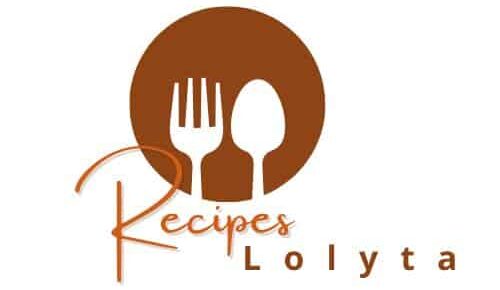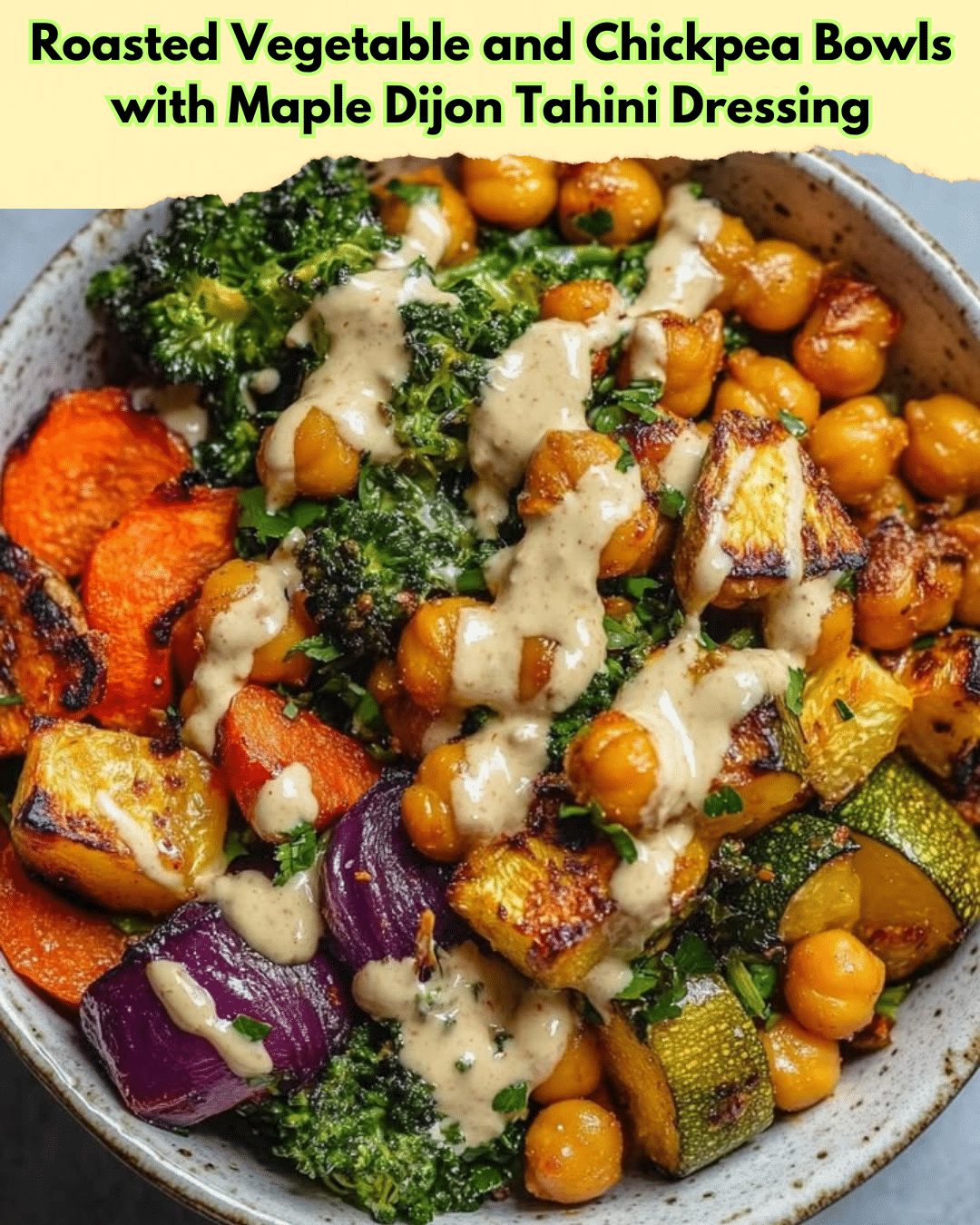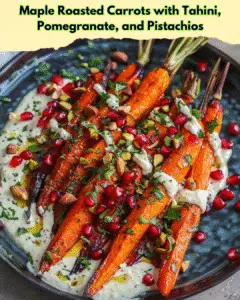Roasted Vegetable and Chickpea Bowls with Maple Dijon Tahini Dressing: A Deliciously Nutritious Meal
Whether you’re looking for a hearty lunch or a healthy dinner option, these Roasted Vegetable and Chickpea Bowls with Maple Dijon Tahini Dressing are the perfect solution. This vibrant dish combines the earthy flavors of roasted vegetables with the nutty richness of chickpeas, all topped with a creamy maple Dijon tahini dressing that adds just the right amount of sweetness and tang. Ready in just about 45 minutes, this recipe is both filling and nutritious, making it an ideal choice for any meal of the day.
Quick Recipe Highlights
– Flavor Profile: This dish is a delightful blend of savory roasted vegetables, nutty chickpeas, and a sweet and tangy maple Dijon tahini dressing that ties everything together beautifully.
– Texture: Enjoy a medley of textures in this dish, from the crisp edges of roasted vegetables to the creamy dressing and the firm bite of chickpeas.
– Aroma: The roasted vegetables provide a warm, inviting aroma, complemented by the fragrant notes of Dijon mustard and maple in the dressing.
– Visual Appeal: With its array of colorful roasted vegetables and chickpeas drizzled generously with dressing, this bowl is as attractive as it is appetizing.
– Skill Level Needed: This recipe is beginner-friendly. Roasting and assembling are straightforward processes, making it accessible for all cooking skill levels.
– Special Equipment: A large baking sheet and a good-quality blender or whisk for the dressing are essential for best results.
Recipe Overview
– Difficulty Level: This recipe is categorized as easy because it relies on simple techniques like roasting and mixing dressing ingredients.
– Category: Perfect for lunch or dinner, this dish falls neatly into the categories of healthy and vegetarian meals.
– Cuisine: Inspired by global flavors, the blend of roasted vegetables, chickpeas, and tahini dressing shows influences from Mediterranean and Middle Eastern cuisines.
– Cost: The recipe is cost-effective, mainly using pantry staples like chickpeas and common vegetables like bell peppers and carrots.
– Season: While great year-round, this dish is especially satisfying in fall and winter when root vegetables are at their peak.
– Occasion: An excellent choice for a weekday meal, this dish is also impressive enough for casual gatherings with friends or family.
Why You’ll Love This Recipe
Taste and texture combine harmoniously in these Roasted Vegetable and Chickpea Bowls. The caramelized sweetness of the vegetables against the creamy, tangy dressing offers depth and satisfaction with every bite. Conveniently designed for easy preparation, the ingredients require minimal fuss, making it a perfect fit for busy weeknights. Not only is it simple to prepare, but it’s also packed with nutritional benefits, offering a balanced mix of carbohydrates, protein, and healthy fats. Plus, it’s a delightful dish for social occasions, offering a vibrant option that caters to diverse dietary preferences. Furthermore, the affordability of its ingredients ensures a delicious meal that won’t break the bank, providing both flavor and value.
Historical Background and Cultural Significance
The concept of grain and vegetable bowls is rooted in historical culinary practices across various cultures. From the Buddha bowls of Asia to the couscous-based dishes of North Africa, the idea of combining grains, vegetables, and proteins into a single dish is universal. This modern iteration draws on Mediterranean influences, notably the use of tahini in the dressing—a staple in Middle Eastern cuisine. Over time, recipes like this have evolved to incorporate local and seasonal produce, reflecting a fusion of flavor profiles from different regions. Today, variations of this recipe can be found worldwide, each adding its own unique twist to the classic formula.
Ingredient Deep Dive
Chickpeas are at the heart of this dish, offering historical significance as a staple crop in the Middle East dating back thousands of years. Nutritionally, they are an excellent source of plant-based protein and dietary fiber. When selecting chickpeas, canned versions offer convenience, though soaking dried chickpeas and cooking them from scratch can enhance their flavor and texture. Store leftover chickpeas in an airtight container in the refrigerator. For those avoiding legumes, cannellini beans can serve as a suitable substitute. The variety of roasted vegetables provides both flavor and nutritional diversity. Carrots, bell peppers, and sweet potatoes come together to offer a mix of vitamins like A, C, and others. Choosing fresh, firm vegetables ensures a superior end product. For storage, keep them in a cool, dark place to extend shelf life. In case an ingredient is unavailable, substituting with seasonal vegetables like zucchini can easily be done.
Common Mistakes to Avoid
– Using unevenly chopped vegetables can lead to uneven cooking times. Always aim for uniformity.
– Overcrowding the baking sheet can steam the vegetables instead of roasting, which can diminish their flavor.
– Not drying the chickpeas thoroughly can result in less crispiness when roasted.
– Ignoring the ratio of dressing ingredients can alter the intended flavor balance.
– Forgetting to preheat the oven may result in longer cooking times and unevenly cooked veggies.
– Skipping the seasoning on vegetables leads to a bland outcome; remember to add salt, pepper, and herbs.
– Leaving out an essential ingredient, such as the acidic element in the dressing, may result in a flat taste.
– Using an incorrect oil with a low smoke point for roasting can lead to burnt-tasting vegetables.
Essential Techniques
For roasting vegetables, achieving that coveted golden-brown crust involves several factors. Always preheat the oven to ensure consistent heat throughout cooking. Use a high-quality olive oil, which aids in flavor and texture. Be sure to spread the vegetables out, leaving space between each piece, allowing for proper air circulation, which aids in even roasting. When preparing the Maple Dijon Tahini Dressing, emulsification is critical to achieving a creamy texture. Slowly whisk the olive oil while combining it with the tahini, maple, and mustard blend. The gradual addition helps the ingredients integrate smoothly.
Pro Tips for Perfect Roasted Vegetable and Chickpea Bowls
– Opt for fresh vegetables; they roast more evenly and taste better.
– Season generously with herbs such as thyme or rosemary for an aromatic touch.
– Elevate the dish by adding toasted nuts or seeds for extra crunch.
– When blending the dressing, gradually add ice water to reach desired consistency.
– Roasting chickpeas separately ensures maximum crispiness.
– Allow the roasted components to cool slightly before assembling to ensure the dressing adheres well.
Variations and Adaptations
This recipe is incredibly adaptable. To create regional variations, consider adding spices like cumin and coriander for a Moroccan twist. For seasonal changes, incorporate winter squash or summer zucchini based on availability. To cater to dietary modifications, a low-carb version can replace chickpeas with grilled chicken for a protein-rich alternative. For a flavor variation, add a hint of smoked paprika to the dressing. If you prefer a smoother texture, consider pureed roasted vegetables as a base for the bowl. Presentation can be adapted by layering ingredients for a visually appealing stacked bowl effect.
Serving and Presentation Guide
Mastering the art of plating can elevate the dining experience. Consider using a shallow bowl to display the colorful array of vegetables and chickpeas. Garnish with freshly chopped parsley or cilantro for an additional splash of color and flavor. Traditional accompaniments such as pita bread make for a satisfying pairing, while modern suggestions include serving alongside a simple mixed green salad. Temperature-wise, these bowls are best enjoyed warm, allowing the dressing flavors to meld beautifully. Manage portion control by pre-measuring each ingredient, ensuring a balanced meal composition.
Wine and Beverage Pairing
When it comes to wine pairings, a crisp Sauvignon Blanc complements the herbal notes in the dish beautifully, while its acidity balances the creamy dressing. For non-alcoholic options, try a fresh mint lemonade, which cuts through the richness and adds a refreshing contrast. If you’re a fan of hot beverages, consider a light green tea that harmonizes with the dish’s diverse flavors. Temperature matters; serve wines slightly chilled to contrast the dish’s warmth. For serving suggestions, decant any wine an hour before serving to allow the flavors to round out.
Storage and Shelf Life
Store leftovers in an airtight container to maintain freshness. The dish keeps well in the refrigerator for up to three days. Use shallow containers to hasten cooling and prevent bacterial growth. Look for indicators of spoilage such as off odors or wilting vegetables. When reheating, warm gently to avoid breaking down the dressing. This dish can be frozen if necessary; wrap well to protect against freezer burn and use within a month for best results.
Make Ahead Strategies
For a seamless experience, consider incorporating make-ahead strategies. Prepare components such as roasted vegetables or the dressing up to two days in advance. Be sure to store them separately to maintain their integrity. Consider the impact of sitting time on flavors; certain spices may intensify. Assemble the bowls just before serving and add fresh elements like herbs at the last minute to maintain their vibrancy. Reheat components gently to preserve textures, making reheating guidelines key for maintaining quality.
Scaling Instructions
Tailor the recipe to fit any gathering size with ease. Halve the ingredients for a solo meal, ensuring equipment such as baking sheets is still appropriately sized. For larger gatherings, simply double or triple the quantities, noting that this may require additional cooking batches. Time management is crucial here—expect extended cooking times with increased quantities. When scaling, storing leftovers involves using appropriately sized containers to maintain freshness and quality.
Nutritional Deep Dive
Understanding the nutritional backbone of this recipe offers insight into its health benefits. Rich in macronutrients, it provides a balance of carbohydrates, proteins, and healthy fats. Chickpeas are a key source of fiber and protein, essential for gut health and satiety. The micronutrients present, such as Vitamin A from carrots and antioxidants from bell peppers, make it a nutritional powerhouse. Consider portion sizes for those following specific dietary plans. For weight management, this dish is a satisfying choice, offering ample nutrients with moderate calorie counts.
Dietary Adaptations
Flexibility in dietary adaptations makes this recipe inclusive. To create a gluten-free version, ensure all dressing ingredients, particularly Dijon mustard, are certified gluten-free. For a dairy-free option, the existing recipe already complies. Vegan adaptation is inherently part of the recipe, catering to those who follow plant-based diets. Adapt for low-carb enthusiasts by focusing on non-starchy vegetables. The keto-diet adapted version can incorporate high-fat garnishes like avocado. Similarly, a paleo version excludes legumes but adds quality proteins like grilled chicken. Consider low-FODMAP substitutions where necessary, replacing chickpeas with suitable alternatives.
Troubleshooting Guide
Achieving the perfect texture involves vigilant monitoring during roasting. If vegetables result soft instead of crisp, consider increasing oven temperature or reducing crowding. For flavor balance, assess the dressing’s acidity, potentially enhancing with extra lemon if needed. Address temperature concerns such as overheating which can alter the dish’s intended freshness. Equipment challenges can arise; ensure quality baking sheets allow even distribution of heat. Substitute any missing ingredients with tact, considering flavors and textures in tandem. Timing concerns, particularly in roasting, can be managed by allocating each component time to cook thoroughly.
Recipe Success Stories
Community interaction has enriched this recipe’s success, with stories illustrating variations that keep it fresh. One reader surpassed initial expectations by introducing a spicy element through chili flakes, adding heat. Another found favor in doubling the batch, highlighting its adaptability for meal prep. Others shared adaptations like adding a poached egg, visually captured in stunning photography. These testimonials celebrate the recipe’s core appeal: flexibility and satisfaction across taste preferences and culinary settings.
Frequently Asked Questions
Yes, dried chickpeas can enhance flavor and texture. Soak them overnight and cook thoroughly before incorporating into the recipe.
Is there a substitute for maple syrup in the dressing?
Honey or agave can be viable substitutes, adjusting for sweetness preferences. Each offers a unique nuance to the dressing.
How should I store the dressing?
Keep dressing refrigerated in an airtight container; shake well before using due to natural ingredient separation.
Can I add grains to this bowl?
Absolutely! Quinoa, farro, or brown rice make excellent additions, adding another layer of texture and flavor.
What other vegetables work well in this recipe?
Feel free to experiment with vegetables like zucchini, eggplant, or broccoli—each offering distinctive flavors and nutrition.
How can I make the dish spicier?
Incorporate spices like cayenne or red pepper flakes to the dressing or roasted chickpeas for an added kick.
Can I freeze the roasted vegetables for later use?
Roasted vegetables can be frozen, though it may impact texture slightly upon defrosting. Consider fresh roasting for the best outcome.
Is this recipe kid-friendly?
Yes, this recipe can be appealing to children, particularly when cutting vegetables into fun shapes or adding a mild dressing option.
How to alter the recipe for winter months?
Incorporating root vegetables like parsnips or squash during the winter complements the seasonal theme beautifully.
What is the best way to reheat?
For optimal results, gently reheat components separately in a skillet, adding the dressing after warming to maintain freshness.
Additional Resources
Enhance your culinary journey by exploring related recipes such as Mediterranean grain salads or tahini-rich hummus variations. Technique guides offer tips on perfecting roasting methods or creating emulsified dressings. Delve deeper into ingredient information, understanding the seasonal availability of produce used in this recipe. Equip your kitchen with suggested gadgets that streamline preparation, from quality blenders for smooth dressings to baking sheets for even roasting. Seasonal variations can inspire fresh takes on this dish, always aligning with the rhythms of the kitchen calendar.
Print
Roasted Vegetable and Chickpea Bowls with Maple Dijon Tahini Dressing
Description
A hearty and healthy bowl filled with roasted vegetables, chickpeas, and a creamy maple dijon tahini dressing.
Ingredients
For the Crust:
- 1 cup chickpeas, drained and rinsed
- 2 cups assorted vegetables (e.g., broccoli, bell peppers, carrots), chopped
- 1/4 cup tahini
- 2 tablespoons maple syrup
- 1 tablespoon Dijon mustard
- 1 tablespoon olive oil
- Salt and pepper to taste
Instructions
1. Prepare the Crust:
- Preheat the oven to 400°F (200°C).
- Toss the chickpeas and vegetables with olive oil, salt, and pepper on a baking sheet. Roast for 25-30 minutes, stirring midway through.
- In a small bowl, whisk together tahini, maple syrup, and Dijon mustard. Drizzle over the roasted vegetables and chickpeas before serving.
Notes
You can customize the seasonings to taste.




